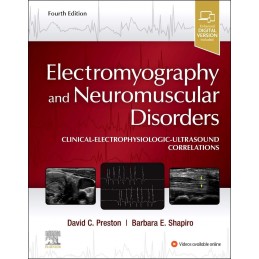- Reduced price

Order to parcel locker

easy pay


 Delivery policy
Delivery policy
Choose Paczkomat Inpost, Orlen Paczka, DHL, DPD or Poczta Polska. Click for more details
 Security policy
Security policy
Pay with a quick bank transfer, payment card or cash on delivery. Click for more details
 Return policy
Return policy
If you are a consumer, you can return the goods within 14 days. Click for more details
Successfully correlate electrodiagnostic findings and neuromuscular ultrasound with key clinical findings with Electromyography and Neuromuscular Disorders, 4th Edition. This popular text is the go-to resource for clinicians at all levels of experience who have an interest in neuromuscular medicine, including those studying for the AANEM board exam. An easy-to-read writing style, abundant case studies, and online videos help you master the electrodiagnostic evaluation and improve safety and accuracy.
Data sheet
Chapter-1: Approach to Nerve Conduction Studies and Electromyography
Chapter-2: Anatomy and Neurophysiology
Section II: Fundamentals of Nerve Conduction StudiesChapter-3: Basic Nerve Conduction Studies
Chapter-4: Late Responses
Chapter-5: Blink Reflex
Chapter-6: Repetitive Nerve Stimulation
Section III: Sources of Error: Anomalies, Artifacts, Technical Factors and StatisticsChapter-7: Anomalous Innervations
Chapter-8: Artifacts and Technical Factors
Chapter-9: Basic Statistics for Electrodiagnostic Studies
Section IV: Detailed Nerve Conduction StudiesChapter-10: Routine Upper Extremity, Facial, and Phrenic Nerve Conduction Techniques
Chapter-11: Routine Lower Extremity Nerve Conduction Techniques
Section V: Fundamentals of ElectromyographyChapter-12: Basic Overview of Electromyography
Chapter-13: Anatomy for Needle Electromyography
Chapter-14: Basic Electromyography: Analysis of Spontaneous Activity
Chapter-15: Basic Electromyography: Analysis of Motor Unit Action Potentials
Section VI: Clinical-Electrophysiologic Correlations Part I: Common Mononeuropathies:Chapter-16: Clinical-Electrophysiologic Correlations: Overview and Common Patterns
Chapter-17: Median Neuropathy at the Wrist
Chapter-18: Proximal Median Neuropathy
Chapter-19: Ulnar Neuropathy at the Elbow
Chapter-20: Ulnar Neuropathy at the Wrist
Chapter-21: Radial Neuropathy
Chapter-22: Peroneal Neuropathy
Chapter-23: Femoral Neuropathy
Chapter-24: Tarsal Tunnel Syndrome
Chapter-25: Facial and Trigeminal Neuropathy
Part II: PolyneuropathyChapter-26: Polyneuropathy
Part III: Motor Neuron DiseaseChapter-27: Amyotrophic Lateral Sclerosis and Its Variants
Chapter-28: Atypical Motor Neuron Disorders
Part IV: Radiculopathy, Plexopathies, and Proximal NeuropathiesChapter-29: Radiculopathy
Chapter-30: Brachial Plexopathy
Chapter-31: Proximal Neuropathies of the Shoulder and Arm
Chapter-32: Lumbosacral Plexopathy
Chapter-33: Sciatic Neuropathy
Part V: Disorders of Neuromuscular Junction and MuscleChapter-34: Neuromuscular Junction Disorders
Chapter-35: Myopathy
Chapter-36: Myotonic Muscle Disorders and Periodic Paralysis Syndromes
Section VII: Electromyography in Special Clinical SettingsChapter-37: Approach to Electrodiagnostic Studies in the Intensive Care Unit
Chapter-38: Approach to Pediatric Electromyography
Section VIII: Electronics and InstrumentationChapter-39: Basics of Electricity and Electronics for Electrodiagnostic Studies
Chapter-40: Electrical Safety and Iatrogenic Complications of Electrodiagnostic Studies
Reference: 16779
Author: Ewa Zamysłowska-Szmytke
Atlas ćwiczeń
Reference: 18434
Author: Steven D. Waldman
Analiza przypadków klinicznych
Reference: 98075
Author: Bashar Katirji
